Impact of Wireless Sensor Networks in the Field of Agriculture
VerifiedAdded on 2023/04/17
|41
|8371
|71
Project
AI Summary
This review-based project examines the impact of Wireless Sensor Networks (WSNs) in the field of agriculture, focusing on energy efficiency, remote monitoring, and the integration of IoT. The project analyzes multiple research papers, including studies on energy-saving mechanisms, the application of the Contiki Cooja simulator, and the use of Non-Negative Matrix Factorization (NMF) for sensor node fault detection. The analysis includes the advantages and disadvantages of various techniques, such as the duty cycle mechanism and the NMF algorithm, along with their respective validation criteria. The project also explores the evolution of the Internet of Things (IoT) in precision agriculture, addressing challenges and future research directions, such as the potential of neural networks and fuzzy logic systems to further improve WSN control strategies. The project also considers the application of Machine Learning to improve the performance of WSNs in smart agriculture. The project also explores the use of algorithms such as NMF and MSPCA methods to determine the performance of systems based on the data acquired by WSNs.

Review Based Project Literature Review (Secondary Research) Template
Student's Name and CSU ID MADAN DHAKAL
Project Type Review Based Project
Project Name Impact of wireless sensor network in the field of agriculture
Technology Wireless sensors network
Techniques Remote monitoring
Domain Agriculture
Version 1.0 _ Week 1
1
Reference in APA format that will be in
'Reference List'
(This give the Reference of the Journal
Paper you are working on it)
Bandur, D, Jaksic, B., Bandur, M., & Jovic, S. (2019). An analysis of energy efficiency in Wireless Sensor
Networks (WSNs) applied in smart agriculture. Computers and Electronics in Agriculture,156, 500-507.
doi:10.1016/j.compag.2018.12.016
Citation that will be in the content (Bandur, Jaksic, Bandur, & Jovic, 2019)
URL of the Reference Level of Journal (Q1, Q2, …Qn) Keywords in this Reference
https://doi.org/10.1016/
j.compag.2018.12.016
Q1 Energy efficiency, Wireless Sensor Networks, Smart
agriculture
1
Student's Name and CSU ID MADAN DHAKAL
Project Type Review Based Project
Project Name Impact of wireless sensor network in the field of agriculture
Technology Wireless sensors network
Techniques Remote monitoring
Domain Agriculture
Version 1.0 _ Week 1
1
Reference in APA format that will be in
'Reference List'
(This give the Reference of the Journal
Paper you are working on it)
Bandur, D, Jaksic, B., Bandur, M., & Jovic, S. (2019). An analysis of energy efficiency in Wireless Sensor
Networks (WSNs) applied in smart agriculture. Computers and Electronics in Agriculture,156, 500-507.
doi:10.1016/j.compag.2018.12.016
Citation that will be in the content (Bandur, Jaksic, Bandur, & Jovic, 2019)
URL of the Reference Level of Journal (Q1, Q2, …Qn) Keywords in this Reference
https://doi.org/10.1016/
j.compag.2018.12.016
Q1 Energy efficiency, Wireless Sensor Networks, Smart
agriculture
1
Paraphrase This Document
Need a fresh take? Get an instant paraphrase of this document with our AI Paraphraser
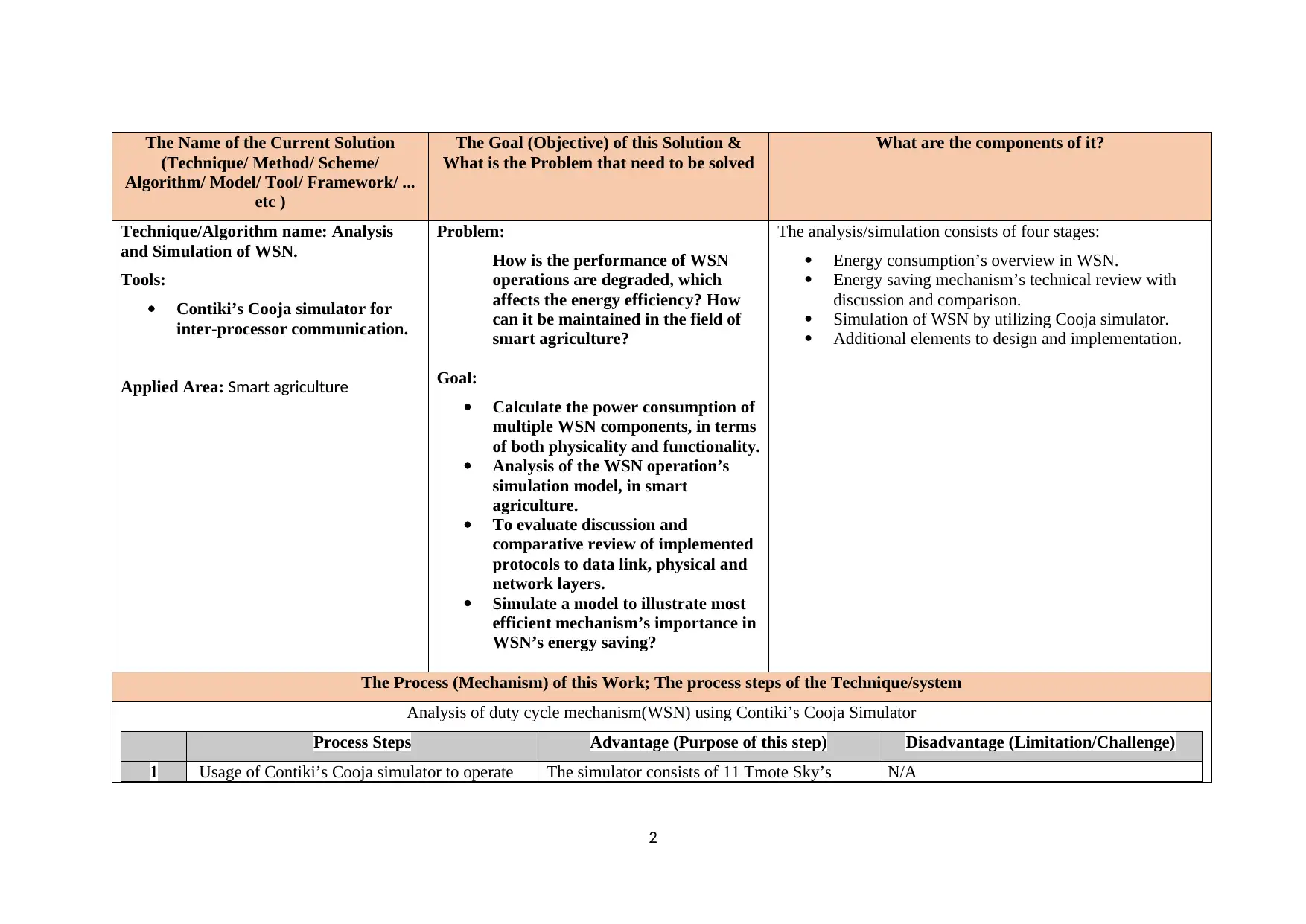
The Name of the Current Solution
(Technique/ Method/ Scheme/
Algorithm/ Model/ Tool/ Framework/ ...
etc )
The Goal (Objective) of this Solution &
What is the Problem that need to be solved
What are the components of it?
Technique/Algorithm name: Analysis
and Simulation of WSN.
Tools:
Contiki’s Cooja simulator for
inter-processor communication.
Applied Area: Smart agriculture
Problem:
How is the performance of WSN
operations are degraded, which
affects the energy efficiency? How
can it be maintained in the field of
smart agriculture?
Goal:
Calculate the power consumption of
multiple WSN components, in terms
of both physicality and functionality.
Analysis of the WSN operation’s
simulation model, in smart
agriculture.
To evaluate discussion and
comparative review of implemented
protocols to data link, physical and
network layers.
Simulate a model to illustrate most
efficient mechanism’s importance in
WSN’s energy saving?
The analysis/simulation consists of four stages:
Energy consumption’s overview in WSN.
Energy saving mechanism’s technical review with
discussion and comparison.
Simulation of WSN by utilizing Cooja simulator.
Additional elements to design and implementation.
The Process (Mechanism) of this Work; The process steps of the Technique/system
Analysis of duty cycle mechanism(WSN) using Contiki’s Cooja Simulator
Process Steps Advantage (Purpose of this step) Disadvantage (Limitation/Challenge)
1 Usage of Contiki’s Cooja simulator to operate The simulator consists of 11 Tmote Sky’s N/A
2
(Technique/ Method/ Scheme/
Algorithm/ Model/ Tool/ Framework/ ...
etc )
The Goal (Objective) of this Solution &
What is the Problem that need to be solved
What are the components of it?
Technique/Algorithm name: Analysis
and Simulation of WSN.
Tools:
Contiki’s Cooja simulator for
inter-processor communication.
Applied Area: Smart agriculture
Problem:
How is the performance of WSN
operations are degraded, which
affects the energy efficiency? How
can it be maintained in the field of
smart agriculture?
Goal:
Calculate the power consumption of
multiple WSN components, in terms
of both physicality and functionality.
Analysis of the WSN operation’s
simulation model, in smart
agriculture.
To evaluate discussion and
comparative review of implemented
protocols to data link, physical and
network layers.
Simulate a model to illustrate most
efficient mechanism’s importance in
WSN’s energy saving?
The analysis/simulation consists of four stages:
Energy consumption’s overview in WSN.
Energy saving mechanism’s technical review with
discussion and comparison.
Simulation of WSN by utilizing Cooja simulator.
Additional elements to design and implementation.
The Process (Mechanism) of this Work; The process steps of the Technique/system
Analysis of duty cycle mechanism(WSN) using Contiki’s Cooja Simulator
Process Steps Advantage (Purpose of this step) Disadvantage (Limitation/Challenge)
1 Usage of Contiki’s Cooja simulator to operate The simulator consists of 11 Tmote Sky’s N/A
2
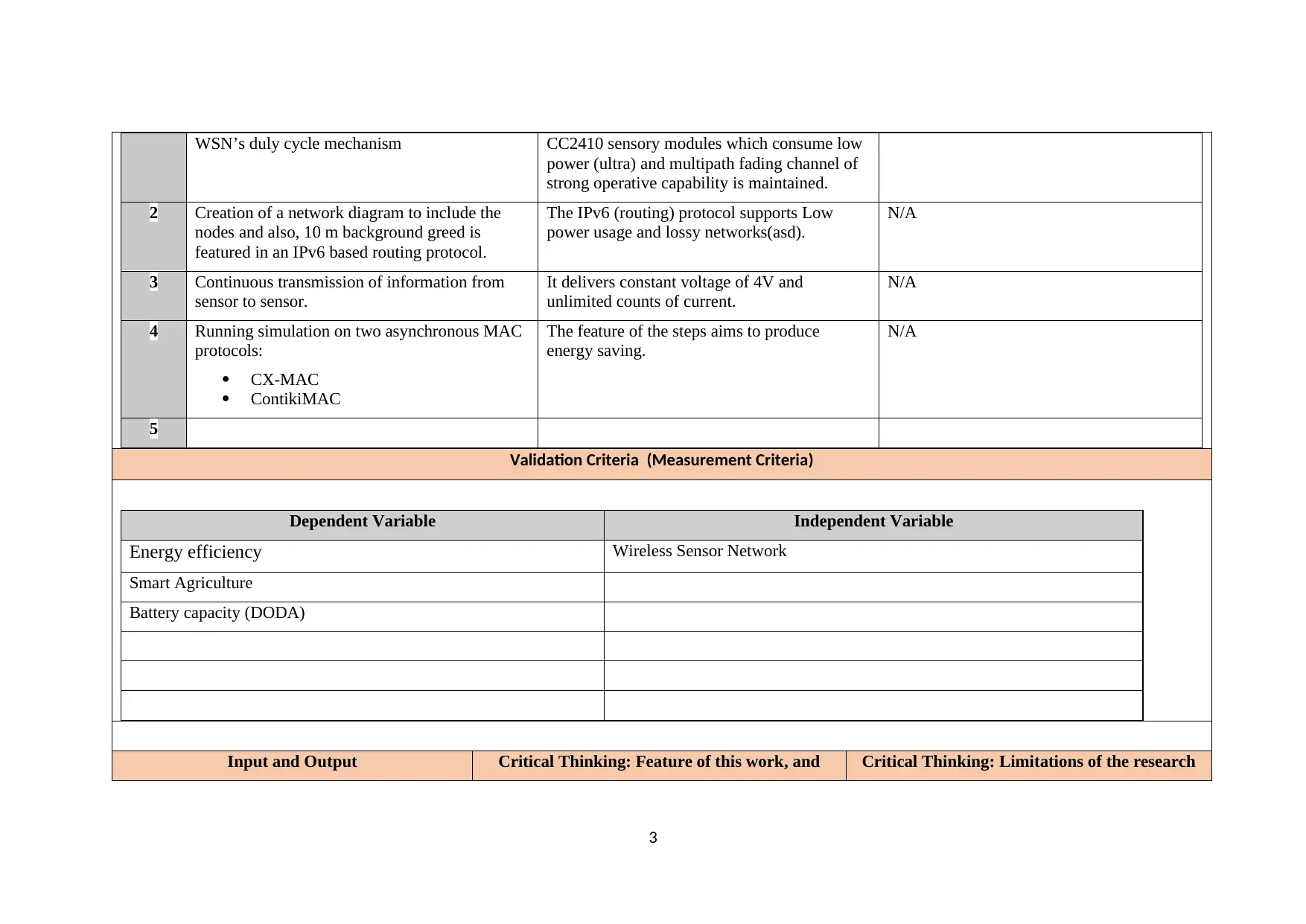
WSN’s duly cycle mechanism CC2410 sensory modules which consume low
power (ultra) and multipath fading channel of
strong operative capability is maintained.
2 Creation of a network diagram to include the
nodes and also, 10 m background greed is
featured in an IPv6 based routing protocol.
The IPv6 (routing) protocol supports Low
power usage and lossy networks(asd).
N/A
3 Continuous transmission of information from
sensor to sensor.
It delivers constant voltage of 4V and
unlimited counts of current.
N/A
4 Running simulation on two asynchronous MAC
protocols:
CX-MAC
ContikiMAC
The feature of the steps aims to produce
energy saving.
N/A
5
Validation Criteria (Measurement Criteria)
Dependent Variable Independent Variable
Energy efficiency Wireless Sensor Network
Smart Agriculture
Battery capacity (DODA)
Input and Output Critical Thinking: Feature of this work, and Critical Thinking: Limitations of the research
3
power (ultra) and multipath fading channel of
strong operative capability is maintained.
2 Creation of a network diagram to include the
nodes and also, 10 m background greed is
featured in an IPv6 based routing protocol.
The IPv6 (routing) protocol supports Low
power usage and lossy networks(asd).
N/A
3 Continuous transmission of information from
sensor to sensor.
It delivers constant voltage of 4V and
unlimited counts of current.
N/A
4 Running simulation on two asynchronous MAC
protocols:
CX-MAC
ContikiMAC
The feature of the steps aims to produce
energy saving.
N/A
5
Validation Criteria (Measurement Criteria)
Dependent Variable Independent Variable
Energy efficiency Wireless Sensor Network
Smart Agriculture
Battery capacity (DODA)
Input and Output Critical Thinking: Feature of this work, and Critical Thinking: Limitations of the research
3
⊘ This is a preview!⊘
Do you want full access?
Subscribe today to unlock all pages.

Trusted by 1+ million students worldwide
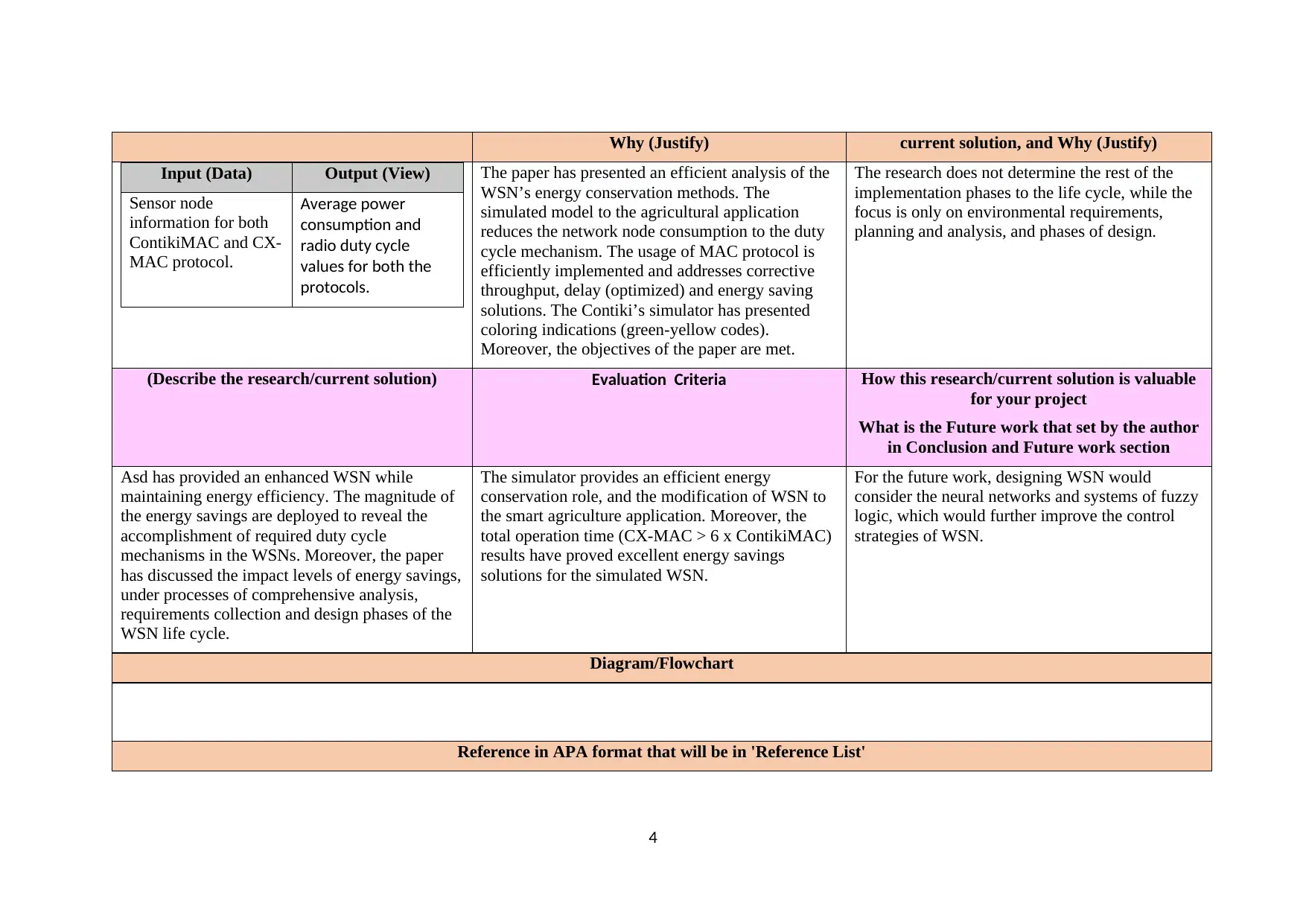
Why (Justify) current solution, and Why (Justify)
Input (Data) Output (View)
Sensor node
information for both
ContikiMAC and CX-
MAC protocol.
Average power
consumption and
radio duty cycle
values for both the
protocols.
The paper has presented an efficient analysis of the
WSN’s energy conservation methods. The
simulated model to the agricultural application
reduces the network node consumption to the duty
cycle mechanism. The usage of MAC protocol is
efficiently implemented and addresses corrective
throughput, delay (optimized) and energy saving
solutions. The Contiki’s simulator has presented
coloring indications (green-yellow codes).
Moreover, the objectives of the paper are met.
The research does not determine the rest of the
implementation phases to the life cycle, while the
focus is only on environmental requirements,
planning and analysis, and phases of design.
(Describe the research/current solution) Evaluation Criteria How this research/current solution is valuable
for your project
What is the Future work that set by the author
in Conclusion and Future work section
Asd has provided an enhanced WSN while
maintaining energy efficiency. The magnitude of
the energy savings are deployed to reveal the
accomplishment of required duty cycle
mechanisms in the WSNs. Moreover, the paper
has discussed the impact levels of energy savings,
under processes of comprehensive analysis,
requirements collection and design phases of the
WSN life cycle.
The simulator provides an efficient energy
conservation role, and the modification of WSN to
the smart agriculture application. Moreover, the
total operation time (CX-MAC > 6 x ContikiMAC)
results have proved excellent energy savings
solutions for the simulated WSN.
For the future work, designing WSN would
consider the neural networks and systems of fuzzy
logic, which would further improve the control
strategies of WSN.
Diagram/Flowchart
Reference in APA format that will be in 'Reference List'
4
Input (Data) Output (View)
Sensor node
information for both
ContikiMAC and CX-
MAC protocol.
Average power
consumption and
radio duty cycle
values for both the
protocols.
The paper has presented an efficient analysis of the
WSN’s energy conservation methods. The
simulated model to the agricultural application
reduces the network node consumption to the duty
cycle mechanism. The usage of MAC protocol is
efficiently implemented and addresses corrective
throughput, delay (optimized) and energy saving
solutions. The Contiki’s simulator has presented
coloring indications (green-yellow codes).
Moreover, the objectives of the paper are met.
The research does not determine the rest of the
implementation phases to the life cycle, while the
focus is only on environmental requirements,
planning and analysis, and phases of design.
(Describe the research/current solution) Evaluation Criteria How this research/current solution is valuable
for your project
What is the Future work that set by the author
in Conclusion and Future work section
Asd has provided an enhanced WSN while
maintaining energy efficiency. The magnitude of
the energy savings are deployed to reveal the
accomplishment of required duty cycle
mechanisms in the WSNs. Moreover, the paper
has discussed the impact levels of energy savings,
under processes of comprehensive analysis,
requirements collection and design phases of the
WSN life cycle.
The simulator provides an efficient energy
conservation role, and the modification of WSN to
the smart agriculture application. Moreover, the
total operation time (CX-MAC > 6 x ContikiMAC)
results have proved excellent energy savings
solutions for the simulated WSN.
For the future work, designing WSN would
consider the neural networks and systems of fuzzy
logic, which would further improve the control
strategies of WSN.
Diagram/Flowchart
Reference in APA format that will be in 'Reference List'
4
Paraphrase This Document
Need a fresh take? Get an instant paraphrase of this document with our AI Paraphraser
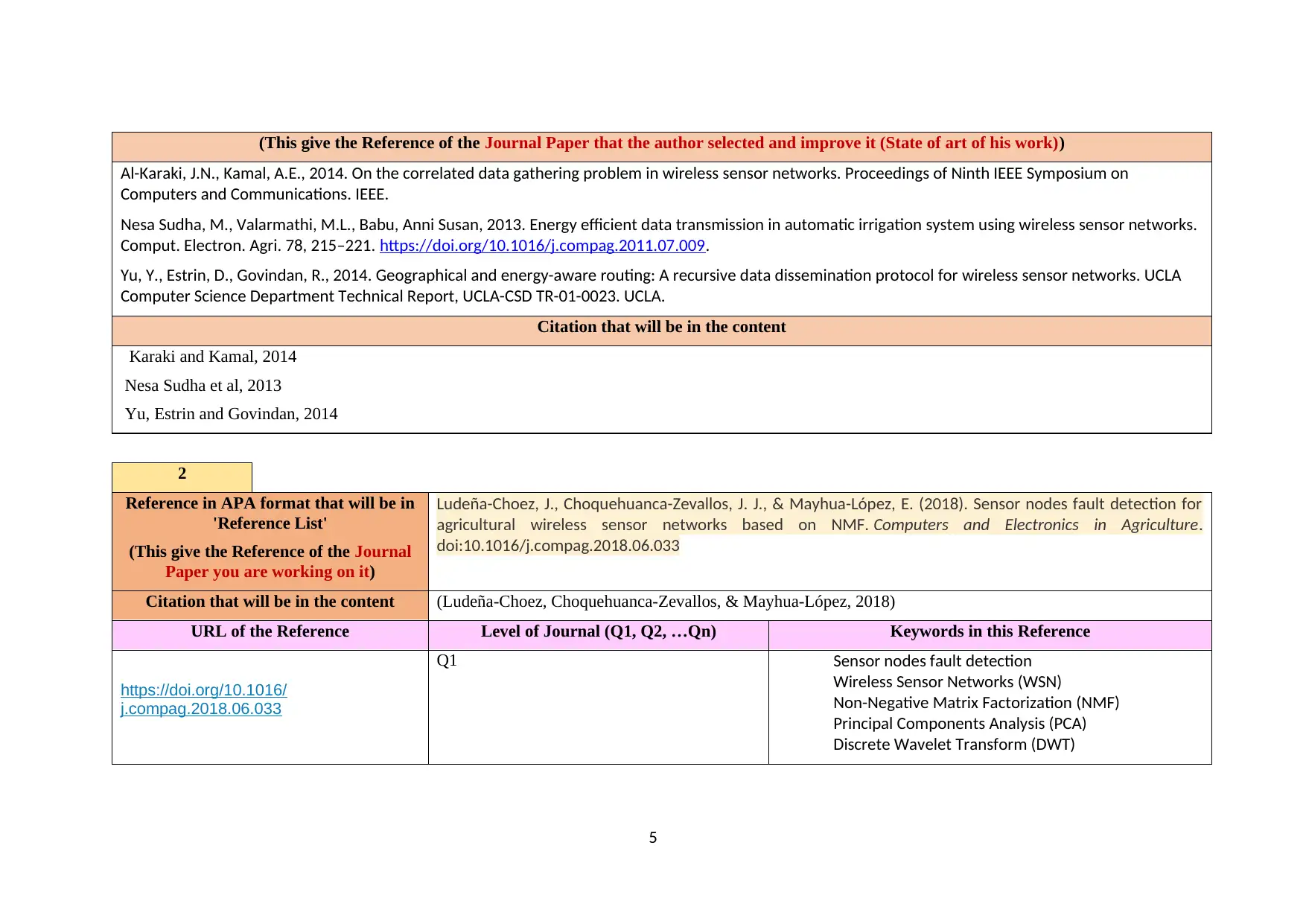
(This give the Reference of the Journal Paper that the author selected and improve it (State of art of his work))
Al-Karaki, J.N., Kamal, A.E., 2014. On the correlated data gathering problem in wireless sensor networks. Proceedings of Ninth IEEE Symposium on
Computers and Communications. IEEE.
Nesa Sudha, M., Valarmathi, M.L., Babu, Anni Susan, 2013. Energy efficient data transmission in automatic irrigation system using wireless sensor networks.
Comput. Electron. Agri. 78, 215–221. https://doi.org/10.1016/j.compag.2011.07.009.
Yu, Y., Estrin, D., Govindan, R., 2014. Geographical and energy-aware routing: A recursive data dissemination protocol for wireless sensor networks. UCLA
Computer Science Department Technical Report, UCLA-CSD TR-01-0023. UCLA.
Citation that will be in the content
Karaki and Kamal, 2014
Nesa Sudha et al, 2013
Yu, Estrin and Govindan, 2014
2
Reference in APA format that will be in
'Reference List'
(This give the Reference of the Journal
Paper you are working on it)
Ludeña-Choez, J., Choquehuanca-Zevallos, J. J., & Mayhua-López, E. (2018). Sensor nodes fault detection for
agricultural wireless sensor networks based on NMF. Computers and Electronics in Agriculture.
doi:10.1016/j.compag.2018.06.033
Citation that will be in the content (Ludeña-Choez, Choquehuanca-Zevallos, & Mayhua-López, 2018)
URL of the Reference Level of Journal (Q1, Q2, …Qn) Keywords in this Reference
https://doi.org/10.1016/
j.compag.2018.06.033
Q1 Sensor nodes fault detection
Wireless Sensor Networks (WSN)
Non-Negative Matrix Factorization (NMF)
Principal Components Analysis (PCA)
Discrete Wavelet Transform (DWT)
5
Al-Karaki, J.N., Kamal, A.E., 2014. On the correlated data gathering problem in wireless sensor networks. Proceedings of Ninth IEEE Symposium on
Computers and Communications. IEEE.
Nesa Sudha, M., Valarmathi, M.L., Babu, Anni Susan, 2013. Energy efficient data transmission in automatic irrigation system using wireless sensor networks.
Comput. Electron. Agri. 78, 215–221. https://doi.org/10.1016/j.compag.2011.07.009.
Yu, Y., Estrin, D., Govindan, R., 2014. Geographical and energy-aware routing: A recursive data dissemination protocol for wireless sensor networks. UCLA
Computer Science Department Technical Report, UCLA-CSD TR-01-0023. UCLA.
Citation that will be in the content
Karaki and Kamal, 2014
Nesa Sudha et al, 2013
Yu, Estrin and Govindan, 2014
2
Reference in APA format that will be in
'Reference List'
(This give the Reference of the Journal
Paper you are working on it)
Ludeña-Choez, J., Choquehuanca-Zevallos, J. J., & Mayhua-López, E. (2018). Sensor nodes fault detection for
agricultural wireless sensor networks based on NMF. Computers and Electronics in Agriculture.
doi:10.1016/j.compag.2018.06.033
Citation that will be in the content (Ludeña-Choez, Choquehuanca-Zevallos, & Mayhua-López, 2018)
URL of the Reference Level of Journal (Q1, Q2, …Qn) Keywords in this Reference
https://doi.org/10.1016/
j.compag.2018.06.033
Q1 Sensor nodes fault detection
Wireless Sensor Networks (WSN)
Non-Negative Matrix Factorization (NMF)
Principal Components Analysis (PCA)
Discrete Wavelet Transform (DWT)
5

The Name of the Current Solution
(Technique/ Method/ Scheme/
Algorithm/ Model/ Tool/ Framework/ ...
etc )
The Goal (Objective) of this Solution &
What is the Problem that need to be solved
What are the components of it?
Technique/Algorithm name: Non-
Negative matrix Factorization Algorithm
Tools: Wireless Sensor network
Applied Area: Farming Resources
Problem: The problems faced in the
optimization of the scarce farming
resources, land monitoring and decision
making.
Goal: To apply NMF and data is acquired for
the spectral representation to extract the
normal behaviour of the sensor node utilizing
the minimum number of features
1. The pre-processing of the data
2. Learning NMF-based sensor nodes normal behavior
model.
3. NMF-based sensor node falut detection
4. Learning MSPCA-based sensor nodes normal
behavior model
5. MSPCA-based sensor node fault detection
6. Decision stage
The Process (Mechanism) of this Work; The process steps of the Technique/system
Process Steps Advantage (Purpose of this step) Disadvantage (Limitation/Challenge)
1 The Non-Negative Matrix Function is applied. The advantage applying the NMF is that it
detects the sensor node fault.
N/A
2 The filtering of the process are done. The advantage of applying this is that it
improves the fault detection.
N/A
3 The NMF-based sensor node fault detection It helps to detect the activation coefficients for
the new signal that comes from each of the
sensors.
N/A
4 The residual projection matrix is utilized It helps in obtaining the coefficient matrix and
the details of the respective matrix structure.
N/A
6
(Technique/ Method/ Scheme/
Algorithm/ Model/ Tool/ Framework/ ...
etc )
The Goal (Objective) of this Solution &
What is the Problem that need to be solved
What are the components of it?
Technique/Algorithm name: Non-
Negative matrix Factorization Algorithm
Tools: Wireless Sensor network
Applied Area: Farming Resources
Problem: The problems faced in the
optimization of the scarce farming
resources, land monitoring and decision
making.
Goal: To apply NMF and data is acquired for
the spectral representation to extract the
normal behaviour of the sensor node utilizing
the minimum number of features
1. The pre-processing of the data
2. Learning NMF-based sensor nodes normal behavior
model.
3. NMF-based sensor node falut detection
4. Learning MSPCA-based sensor nodes normal
behavior model
5. MSPCA-based sensor node fault detection
6. Decision stage
The Process (Mechanism) of this Work; The process steps of the Technique/system
Process Steps Advantage (Purpose of this step) Disadvantage (Limitation/Challenge)
1 The Non-Negative Matrix Function is applied. The advantage applying the NMF is that it
detects the sensor node fault.
N/A
2 The filtering of the process are done. The advantage of applying this is that it
improves the fault detection.
N/A
3 The NMF-based sensor node fault detection It helps to detect the activation coefficients for
the new signal that comes from each of the
sensors.
N/A
4 The residual projection matrix is utilized It helps in obtaining the coefficient matrix and
the details of the respective matrix structure.
N/A
6
⊘ This is a preview!⊘
Do you want full access?
Subscribe today to unlock all pages.

Trusted by 1+ million students worldwide
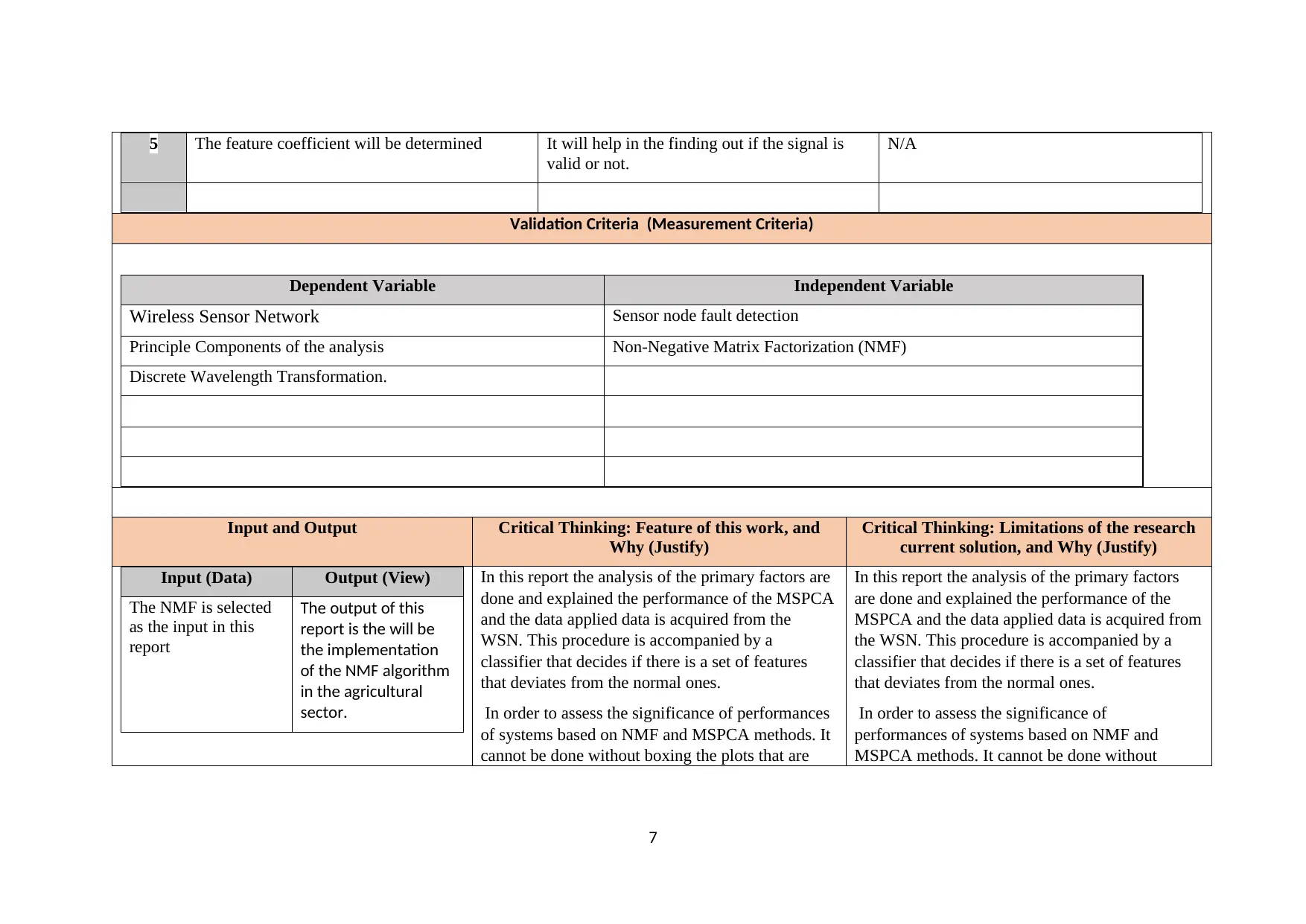
5 The feature coefficient will be determined It will help in the finding out if the signal is
valid or not.
N/A
Validation Criteria (Measurement Criteria)
Dependent Variable Independent Variable
Wireless Sensor Network Sensor node fault detection
Principle Components of the analysis Non-Negative Matrix Factorization (NMF)
Discrete Wavelength Transformation.
Input and Output Critical Thinking: Feature of this work, and
Why (Justify)
Critical Thinking: Limitations of the research
current solution, and Why (Justify)
Input (Data) Output (View)
The NMF is selected
as the input in this
report
The output of this
report is the will be
the implementation
of the NMF algorithm
in the agricultural
sector.
In this report the analysis of the primary factors are
done and explained the performance of the MSPCA
and the data applied data is acquired from the
WSN. This procedure is accompanied by a
classifier that decides if there is a set of features
that deviates from the normal ones.
In order to assess the significance of performances
of systems based on NMF and MSPCA methods. It
cannot be done without boxing the plots that are
In this report the analysis of the primary factors
are done and explained the performance of the
MSPCA and the data applied data is acquired from
the WSN. This procedure is accompanied by a
classifier that decides if there is a set of features
that deviates from the normal ones.
In order to assess the significance of
performances of systems based on NMF and
MSPCA methods. It cannot be done without
7
valid or not.
N/A
Validation Criteria (Measurement Criteria)
Dependent Variable Independent Variable
Wireless Sensor Network Sensor node fault detection
Principle Components of the analysis Non-Negative Matrix Factorization (NMF)
Discrete Wavelength Transformation.
Input and Output Critical Thinking: Feature of this work, and
Why (Justify)
Critical Thinking: Limitations of the research
current solution, and Why (Justify)
Input (Data) Output (View)
The NMF is selected
as the input in this
report
The output of this
report is the will be
the implementation
of the NMF algorithm
in the agricultural
sector.
In this report the analysis of the primary factors are
done and explained the performance of the MSPCA
and the data applied data is acquired from the
WSN. This procedure is accompanied by a
classifier that decides if there is a set of features
that deviates from the normal ones.
In order to assess the significance of performances
of systems based on NMF and MSPCA methods. It
cannot be done without boxing the plots that are
In this report the analysis of the primary factors
are done and explained the performance of the
MSPCA and the data applied data is acquired from
the WSN. This procedure is accompanied by a
classifier that decides if there is a set of features
that deviates from the normal ones.
In order to assess the significance of
performances of systems based on NMF and
MSPCA methods. It cannot be done without
7
Paraphrase This Document
Need a fresh take? Get an instant paraphrase of this document with our AI Paraphraser

obtained for the faults boxing the plots that are obtained for the faults
(Describe the research/current solution) Evaluation Criteria How this research/current solution is valuable
for your project
What is the Future work that set by the author
in Conclusion and Future work section
The research is based on the implementation of
the NMF in the precision agriculture and the
challenges faced and how to overcome the
problems.
The study helps in overcoming the problems that
are faced in the implementation of the NMF. An
alternative method for feature extraction based on
NMF to detect faults in soil moisture readings was
presented. The system models the normal behaviour
of the sensor nodes from the spectral basis vectors
obtained after applying the NMF algorithm over the
spectral magnitude of the sensed data.
The NMF can be used in the future for the
implementation in the precision agriculture and for
the optimization of the scarce farming, land
monitoring and decision making support.
Diagram/Flowchart
Reference in APA format that will be in 'Reference List'
(This give the Reference of the Journal Paper that the author selected and improve it (State of art of his work))
Giantomassi, A., Ferracuri, F., Iarlori, S., Puglia, G., Fonti, A., Comodi, G., Longhi, S.,
2014. Smart home heating system malfunction and bad behavior diagnosis by multiscale
PCA under indoor temperature feedback control. In: 22nd Mediterranean Conf.
on Control and Automation, pp. 876–881.
8
(Describe the research/current solution) Evaluation Criteria How this research/current solution is valuable
for your project
What is the Future work that set by the author
in Conclusion and Future work section
The research is based on the implementation of
the NMF in the precision agriculture and the
challenges faced and how to overcome the
problems.
The study helps in overcoming the problems that
are faced in the implementation of the NMF. An
alternative method for feature extraction based on
NMF to detect faults in soil moisture readings was
presented. The system models the normal behaviour
of the sensor nodes from the spectral basis vectors
obtained after applying the NMF algorithm over the
spectral magnitude of the sensed data.
The NMF can be used in the future for the
implementation in the precision agriculture and for
the optimization of the scarce farming, land
monitoring and decision making support.
Diagram/Flowchart
Reference in APA format that will be in 'Reference List'
(This give the Reference of the Journal Paper that the author selected and improve it (State of art of his work))
Giantomassi, A., Ferracuri, F., Iarlori, S., Puglia, G., Fonti, A., Comodi, G., Longhi, S.,
2014. Smart home heating system malfunction and bad behavior diagnosis by multiscale
PCA under indoor temperature feedback control. In: 22nd Mediterranean Conf.
on Control and Automation, pp. 876–881.
8
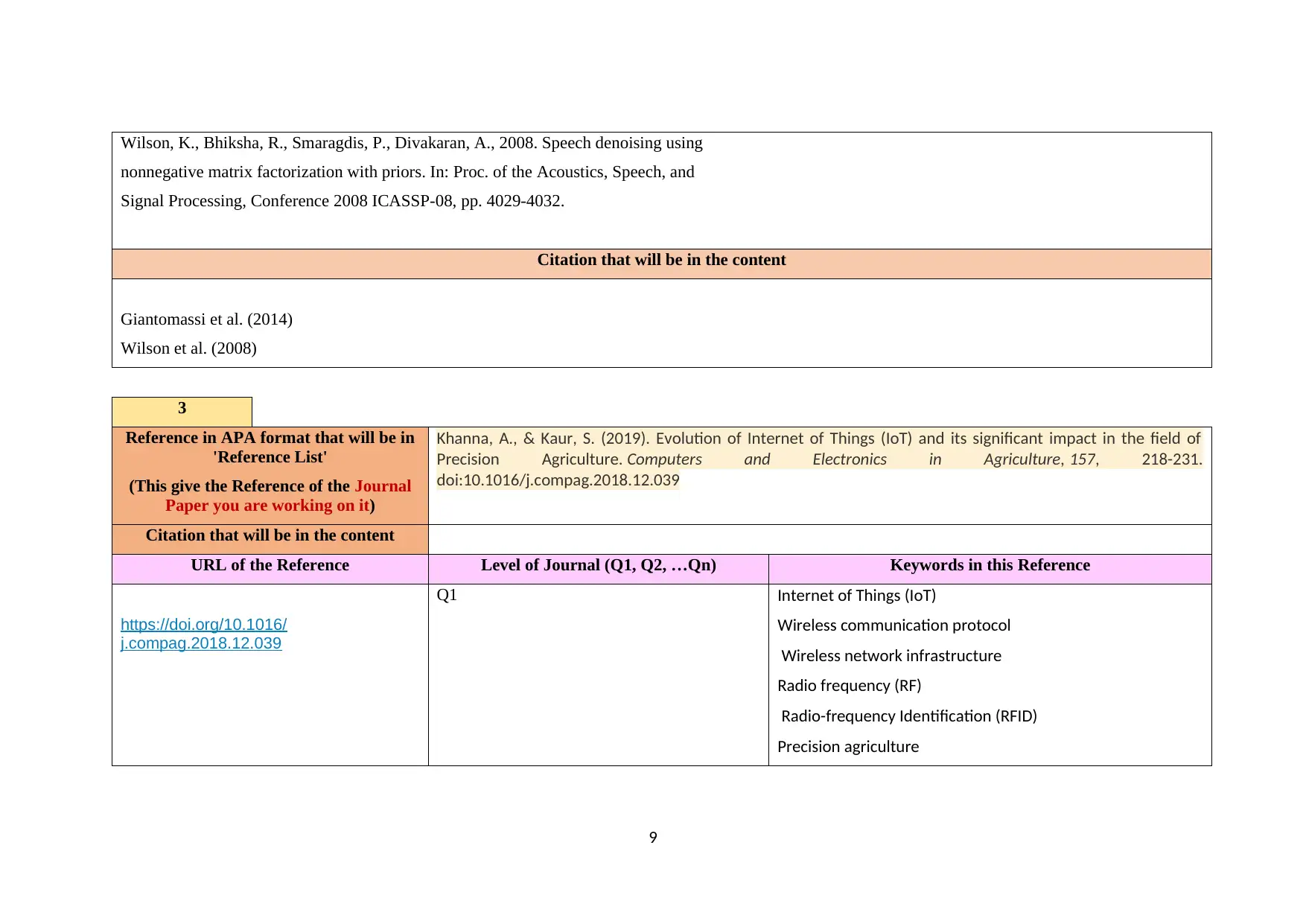
Wilson, K., Bhiksha, R., Smaragdis, P., Divakaran, A., 2008. Speech denoising using
nonnegative matrix factorization with priors. In: Proc. of the Acoustics, Speech, and
Signal Processing, Conference 2008 ICASSP-08, pp. 4029-4032.
Citation that will be in the content
Giantomassi et al. (2014)
Wilson et al. (2008)
3
Reference in APA format that will be in
'Reference List'
(This give the Reference of the Journal
Paper you are working on it)
Khanna, A., & Kaur, S. (2019). Evolution of Internet of Things (IoT) and its significant impact in the field of
Precision Agriculture. Computers and Electronics in Agriculture, 157, 218-231.
doi:10.1016/j.compag.2018.12.039
Citation that will be in the content
URL of the Reference Level of Journal (Q1, Q2, …Qn) Keywords in this Reference
https://doi.org/10.1016/
j.compag.2018.12.039
Q1 Internet of Things (IoT)
Wireless communication protocol
Wireless network infrastructure
Radio frequency (RF)
Radio-frequency Identification (RFID)
Precision agriculture
9
nonnegative matrix factorization with priors. In: Proc. of the Acoustics, Speech, and
Signal Processing, Conference 2008 ICASSP-08, pp. 4029-4032.
Citation that will be in the content
Giantomassi et al. (2014)
Wilson et al. (2008)
3
Reference in APA format that will be in
'Reference List'
(This give the Reference of the Journal
Paper you are working on it)
Khanna, A., & Kaur, S. (2019). Evolution of Internet of Things (IoT) and its significant impact in the field of
Precision Agriculture. Computers and Electronics in Agriculture, 157, 218-231.
doi:10.1016/j.compag.2018.12.039
Citation that will be in the content
URL of the Reference Level of Journal (Q1, Q2, …Qn) Keywords in this Reference
https://doi.org/10.1016/
j.compag.2018.12.039
Q1 Internet of Things (IoT)
Wireless communication protocol
Wireless network infrastructure
Radio frequency (RF)
Radio-frequency Identification (RFID)
Precision agriculture
9
⊘ This is a preview!⊘
Do you want full access?
Subscribe today to unlock all pages.

Trusted by 1+ million students worldwide

Smart agriculture
The Name of the Current Solution
(Technique/ Method/ Scheme/
Algorithm/ Model/ Tool/ Framework/ ...
etc )
The Goal (Objective) of this Solution &
What is the Problem that need to be solved
What are the components of it?
Technique/Algorithm name:
Internet of Things
Real time monitoring
Tools: Wireless Sensor Network
Applied Area: Internet of Things
Problem: To identify the optimal potential
of the internet usage.
Goal: The goal of the project is to identify
the current position of IoT in Precision
Agriculture
Internet of Things
Precision Agriculture
Wireless Network Infrastructure
The Process (Mechanism) of this Work; The process steps of the Technique/system
Process Steps Advantage (Purpose of this step) Disadvantage (Limitation/Challenge)
1 Survey of the articles It help to motivate the researchers in the study. N/A
2 Related surveys are done It helps to gather knowledge of the previous
researches.
N/A
3 The research methodology and the method of
classification is studied
It helped in identifying the literature of the
comprehensive review.
N/A
4
Validation Criteria (Measurement Criteria)
10
The Name of the Current Solution
(Technique/ Method/ Scheme/
Algorithm/ Model/ Tool/ Framework/ ...
etc )
The Goal (Objective) of this Solution &
What is the Problem that need to be solved
What are the components of it?
Technique/Algorithm name:
Internet of Things
Real time monitoring
Tools: Wireless Sensor Network
Applied Area: Internet of Things
Problem: To identify the optimal potential
of the internet usage.
Goal: The goal of the project is to identify
the current position of IoT in Precision
Agriculture
Internet of Things
Precision Agriculture
Wireless Network Infrastructure
The Process (Mechanism) of this Work; The process steps of the Technique/system
Process Steps Advantage (Purpose of this step) Disadvantage (Limitation/Challenge)
1 Survey of the articles It help to motivate the researchers in the study. N/A
2 Related surveys are done It helps to gather knowledge of the previous
researches.
N/A
3 The research methodology and the method of
classification is studied
It helped in identifying the literature of the
comprehensive review.
N/A
4
Validation Criteria (Measurement Criteria)
10
Paraphrase This Document
Need a fresh take? Get an instant paraphrase of this document with our AI Paraphraser

Dependent Variable Independent Variable
Internet of Things Precision Agriculture
Wireless Communication Protocol Smart Agriculture
Radio Frequency Radio frequency Identifier
Input and Output Critical Thinking: Feature of this work, and
Why (Justify)
Critical Thinking: Limitations of the research
current solution, and Why (Justify)
Input (Data) Output (View)
The input of this
report will be the
implementation of the
IoT.
The output of this
study will be the
current position of
the IoT in the
precision agriculture.
Even though the IoT was proposed a couple of
years ago the implementation of the IoT has
become the benchmark for the establishment of the
communication. The motive of this study is to study
the implementation of IoT in the field of
agriculture.
The complete understanding of the IoT
Architecture is the biggest challenge in the
implementation of this technique. The rise of
issues with the updates that are associated with the
constant advancement of the domain.
(Describe the research/current solution) Evaluation Criteria How this research/current solution is valuable
for your project
What is the Future work that set by the author
in Conclusion and Future work section
The main solution of the research are that the
research aims is to extend the capabilities from
IPv4 to IPv6. To develop the high scalable IPv6
based SOA that is capable to solve the issues.
The solution that is provides an acceptable range of
accuracy. The RFID system is composed of many
readers’ tags and the use of make of radio
frequency electromagnetic to transfer the data. The
M2M communication is used to increase the
The IoT can be used for the contribution in the
modern area of advancement of the agriculture.
Extensive research in the field of IoT and
precision Agriculture will take a gigantic leap for
11
Internet of Things Precision Agriculture
Wireless Communication Protocol Smart Agriculture
Radio Frequency Radio frequency Identifier
Input and Output Critical Thinking: Feature of this work, and
Why (Justify)
Critical Thinking: Limitations of the research
current solution, and Why (Justify)
Input (Data) Output (View)
The input of this
report will be the
implementation of the
IoT.
The output of this
study will be the
current position of
the IoT in the
precision agriculture.
Even though the IoT was proposed a couple of
years ago the implementation of the IoT has
become the benchmark for the establishment of the
communication. The motive of this study is to study
the implementation of IoT in the field of
agriculture.
The complete understanding of the IoT
Architecture is the biggest challenge in the
implementation of this technique. The rise of
issues with the updates that are associated with the
constant advancement of the domain.
(Describe the research/current solution) Evaluation Criteria How this research/current solution is valuable
for your project
What is the Future work that set by the author
in Conclusion and Future work section
The main solution of the research are that the
research aims is to extend the capabilities from
IPv4 to IPv6. To develop the high scalable IPv6
based SOA that is capable to solve the issues.
The solution that is provides an acceptable range of
accuracy. The RFID system is composed of many
readers’ tags and the use of make of radio
frequency electromagnetic to transfer the data. The
M2M communication is used to increase the
The IoT can be used for the contribution in the
modern area of advancement of the agriculture.
Extensive research in the field of IoT and
precision Agriculture will take a gigantic leap for
11

communication technique in the last few years. the betterment of mankind. In the next few years,
major agriculture sensors, actuators and devices
would be connected over the Internet with the
basic objective of interaction, controlling, and
decision making.
Diagram/Flowchart
Reference in APA format that will be in 'Reference List'
(This give the Reference of the Journal Paper that the author selected and improve it (State of art of his work))
Ojha, T., Misra, S., Raghuwanshi, N.S., 2015. Wireless sensor networks for agriculture: the
state-of-the-art in practice and future challenges. Comput. Electron. Agric. 118,
66–84.
Zhang, M., Sun, F., Cheng, X., 2012. Architecture of internet of things and its key technology
integration based-on RFID. In: Computational Intelligence and Design (ISCID),
2012 Fifth International Symposium on, vol. 1. IEEE, pp. 294–297.
Citation that will be in the content
Ojha, Misra & Raghuwansi (2015)
Zhang, Sun & Cheng (2012s)
4
12
major agriculture sensors, actuators and devices
would be connected over the Internet with the
basic objective of interaction, controlling, and
decision making.
Diagram/Flowchart
Reference in APA format that will be in 'Reference List'
(This give the Reference of the Journal Paper that the author selected and improve it (State of art of his work))
Ojha, T., Misra, S., Raghuwanshi, N.S., 2015. Wireless sensor networks for agriculture: the
state-of-the-art in practice and future challenges. Comput. Electron. Agric. 118,
66–84.
Zhang, M., Sun, F., Cheng, X., 2012. Architecture of internet of things and its key technology
integration based-on RFID. In: Computational Intelligence and Design (ISCID),
2012 Fifth International Symposium on, vol. 1. IEEE, pp. 294–297.
Citation that will be in the content
Ojha, Misra & Raghuwansi (2015)
Zhang, Sun & Cheng (2012s)
4
12
⊘ This is a preview!⊘
Do you want full access?
Subscribe today to unlock all pages.

Trusted by 1+ million students worldwide
1 out of 41
Related Documents
Your All-in-One AI-Powered Toolkit for Academic Success.
+13062052269
info@desklib.com
Available 24*7 on WhatsApp / Email
![[object Object]](/_next/static/media/star-bottom.7253800d.svg)
Unlock your academic potential
Copyright © 2020–2025 A2Z Services. All Rights Reserved. Developed and managed by ZUCOL.





